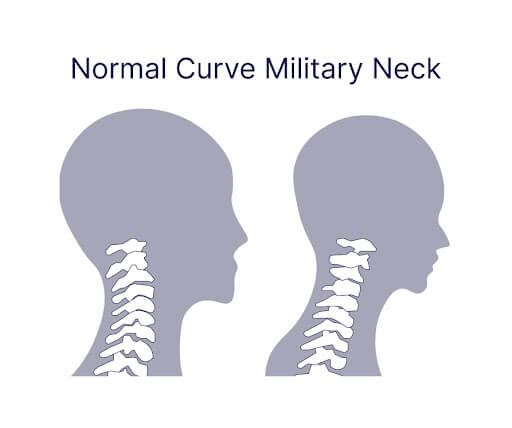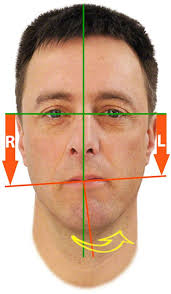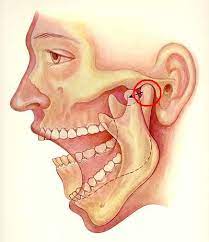

Imagine standing at attention, shoulders pulled back, head thrust forward in a rigid, upright stance.
While the “military neck posture” may sound like it embodies discipline, it can have some surprising side effects — particularly on jaw alignment.
When the neck vertebrae straighten abnormally, creating an almost vertical alignment, it does not just affect the neck; it can lead to a ripple effect impacting the jaw, creating discomfort, stiffness, and even pain.
In this article, we are going to break down exactly how military neck posture — often known in the medical world as “cervical kyphosis” — affects jaw alignment.
Article Index
- What is Military Neck Posture?
- How Neck Alignment Affects Jaw Position
- Impact of Military Neck Posture on Jaw Muscles
- Why Military Neck Posture Causes Jaw Misalignment
- Real-Life Example: A Day in the Life with Military Neck Posture
- Scientific Evidence on Military Neck and Jaw Alignment
- Effects of Jaw Misalignment on Daily Life
- Conclusion: The Chain Reaction of Misalignment
What is Military Neck Posture?
Military neck posture, or cervical kyphosis, occurs when the normal curvature of the neck straightens out or even curves forward.
A healthy neck typically has a natural “C” shape when viewed from the side, allowing for shock absorption, stability, and flexibility.
However, in cases of military neck posture, this curve diminishes or reverses entirely, creating a more rigid, upright stance.
This postural change affects the entire cervical spine, causing strain on the neck muscles, which in turn affects nearby structures like the jaw.
The head, typically positioned over the spine for balance, shifts forward, creating an imbalance that impacts the muscles supporting the jaw, leading to alignment issues.
How Neck Alignment Affects Jaw Position?
Your neck and jaw are connected in more ways than one.
When the neck’s alignment is off, the jaw has to adapt.
Imagine it as a domino effect: when one part of the musculoskeletal system shifts, the structures nearby compensate.
In military neck posture, the spine loses its natural curve, causing the head to tilt forward.
This forward head position pulls on the muscles of the neck, particularly the sternocleidomastoid and upper trapezius muscles, which then transfer stress onto the jaw muscles.
Over time, this misalignment leads to what’s known as “temporomandibular joint disorder” (TMD), causing issues like clicking, pain, and misalignment in the jaw.
Impact of Military Neck Posture on Jaw Muscles
The jaw muscles, including the masseter, temporalis, and pterygoid muscles, work continuously to support functions like chewing and speaking.
However, when the head moves forward due to military neck posture, these muscles are forced to adapt to the new alignment, leading to a form of overcompensation.
According to a study published in the Journal of Oral Rehabilitation, when neck alignment shifts, the associated tension in the muscles can disrupt the natural function of the jaw muscles, causing them to work harder to keep the jaw aligned.
Over time, this strain can lead to muscle fatigue, soreness, and misalignment, causing pain and discomfort in both the neck and jaw.
Why Military Neck Posture Causes Jaw Misalignment?
One of the main reasons military neck posture affects jaw alignment is because of the body’s need for balance.
The head, when pushed forward, throws off the alignment of the upper spine and, by extension, the jaw.
This unnatural position puts additional stress on the temporomandibular joint (TMJ), which connects the jawbone to the skull, and is responsible for all jaw movements.
With prolonged forward head posture, the TMJ becomes strained, altering its natural alignment.
Dr. Paul Durham from Missouri State University states that “forward head posture can increase the load on the temporomandibular joint by over 30%,” forcing the joint and surrounding muscles into an unnatural position.
Over time, this misalignment can cause the jaw to shift, leading to painful and often persistent issues like jaw clicking and reduced range of motion.
Real-Life Example: A Day in the Life with Military Neck Posture
Let’s consider a real-life example to illustrate these points.
Meet Tom, a 32-year-old software engineer.
Tom spends hours every day in front of his computer, often with his head leaning forward.
Recently, he has noticed that his jaw clicks when he chews and occasionally locks up, making it painful to open his mouth wide.
Unbeknownst to Tom, his military neck posture is affecting his jaw alignment.
The strain in his neck from leaning forward to see the screen causes his jaw muscles to tighten, impacting the way his jaw aligns with his skull.
Tom’s experience is all too common, as lifestyle habits like prolonged screen time can create or exacerbate military neck posture, affecting jaw alignment and function.
Scientific Evidence on Military Neck and Jaw Alignment
There is ample research highlighting the link between military neck posture and jaw misalignment.
A study in Clinical Biomechanics explored the relationship between head posture and TMJ disorders, concluding that abnormal head posture significantly increases the likelihood of jaw misalignment and associated pain.
Another research piece published in The Journal of Physical Therapy Science found that individuals with forward head posture experienced a higher incidence of TMD and jaw pain, emphasizing how even small shifts in neck alignment can impact the jaw.
These studies underscore how military neck posture can impact more than just the neck — it can cascade down, affecting jaw function and alignment.
Effects of Jaw Misalignment on Daily Life
Jaw misalignment is not just a minor inconvenience.
For those suffering from it due to military neck posture, daily activities can become challenging.
1. Chewing Becomes a Chore:
Jaw misalignment can make something as routine as chewing feel awkward or painful. Because the teeth no longer meet properly, you may favor one side, which can lead to uneven muscle use, jaw fatigue, or even biting your cheek or tongue more often than you’d like.
2. Speaking Gets Strained:
Whether it is giving a presentation or just chatting with a friend, talking for long periods can become uncomfortable. Misalignment places stress on the jaw muscles and joints, sometimes causing tension, clicking, or soreness after extended use.
3. Yawning and Smiling Can Hurt:
Opening your mouth wide—whether to yawn, laugh, or eat—can trigger sharp discomfort if the jaw is out of alignment. Over time, people may subconsciously limit mouth movement, affecting not only comfort but self-expression.
4. Headaches and Ear Pain Creep In:
The stress from a misaligned jaw does not stay local—it often travels upward. Many people experience frequent tension headaches or a sense of pressure near the ears due to the strain on surrounding muscles and nerves.
5. Sleep Takes a Hit:
Jaw misalignment is commonly linked to teeth grinding (bruxism), especially at night. This can disrupt sleep quality, wear down teeth, and leave you waking up with a sore jaw or neck stiffness.
6. Emotional and Social Impact:
Pain or discomfort during basic interactions like eating or speaking can affect mood, reduce confidence, and create social anxiety—especially if jaw sounds or limited mobility become noticeable to others.
.
Takeaway: The Chain Reaction of Misalignment
Military neck posture does not just affect the neck; it has a domino effect that extends to the jaw.
By disrupting the natural curve of the cervical spine, this posture creates strain on both the neck and jaw muscles, forcing them to adapt in ways that lead to misalignment, discomfort, and even pain.
While this article focused on the relationship between military neck posture and jaw alignment, understanding the root of the issue is the first step in addressing it.
As per BestForwardHeadPostureFix research, “Recognizing how posture influences different parts of the body can make a world of difference, empowering individuals to take proactive measures to prevent further complications”.
In future discussions, solutions to correct military neck posture and alleviate jaw misalignment can provide the path toward a pain-free life.
References:

